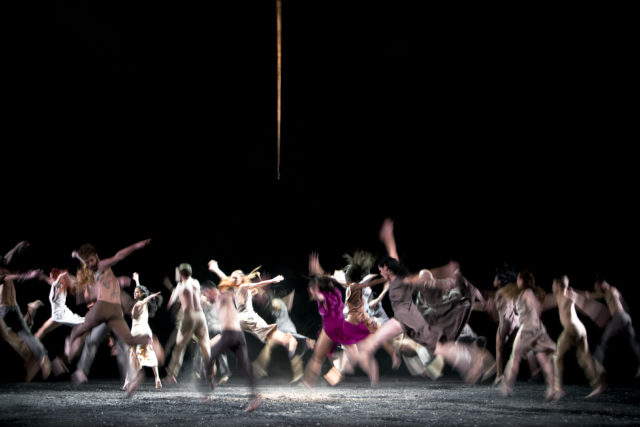
For the English version, please, scroll down
Domenica sera, allo Staatsoper im Schiller Theater in Berlin, è andato in scena Sacre di Sasha Waltz.
Lo spettacolo, diviso in tre parti, si è aperto con una coreografia su musiche di Debussy – Prélude à l’après-midi d’un faune, ispirata all’omonimo poema di Mallarmé.
Accompagnato dall’orchestra dal vivo, il corpo di ballo, con costumi dai colori sgargianti e su un palco dal fondale altrettanto variopinto, si è esibito in una danza fatta di languidi abbracci, sensuali carezze e improvvisi guizzi corali che rompevano la fluidità del movimento.
In una performance priva di virtuosismi, i danzatori sono riusciti a descrivere con ironia e sensualità il racconto sognante del fauno e del suo incontro con le ninfe.
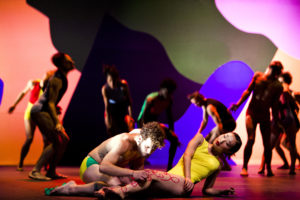
Con la seconda coreografia, su musica tratta da Roméo et Juliette di Berlioz, si continua a parlare d’amore.
Quasi ad amplificare la differenza tra i due racconti, uno erotico e l’altro romantico, in scena ci sono solo i due protagonisti del dramma shakespeariano. La danza, prima fisica e terrena, ora diventa eterea e delicata. In un passo a due dallo stile neoclassico, i due giovani innamorati riempiono lo spazio volteggiando e rincorrendosi in un dolce corteggiamento.
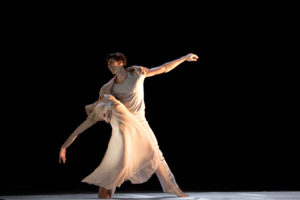
Dopo un breve intervallo, lo spettacolo si è chiuso con Sacre du printemps di Stravinskij.
Con l’ultimo pezzo si torna a una coreografia corale che ha impegnato circa trenta danzatori sul palco.
Al di là dell’amore romantico di Giulietta e Romeo e delle fantasie lussuriose del fauno,
emerge, in quest’ultimo quadro, l’antichissimo rituale del possesso della vergine.
Una danza primitiva e arcaica contrappone e separa in due gruppi donne e uomini. Le prime si cercano e si abbracciano, esprimendo sentimenti di solidarietà e preoccupazione per il gruppo, mentre gli uomini, più ‘bestiali’, danzano e saltano a torso nudo.

Il balletto termina con il sacrificio di una donna.
Il segnale è il cambio d’abito della prescelta che si spoglia della tunica color terra indossata dalle altre donne per vestirne una viola.
Nel gran finale, nuda, sotto il cono di luce accecante, la vittima sacrificale danza fino allo spasimo.
Mentre il gruppo resta a osservarla in disparte, da lontano, lei cade lì dove è puntata la lancia.
Ancora una volta Sasha Waltz offre uno spettacolo che lascia il pubblico entusiasta.
Nei tre brani, le coreografie sono perfettamente accompagnate dalla musica di Debussy, Berlioz e Stravinskij. Trascinante e coinvolgente il primo pezzo, meno sorprendente il passo a due, e di grande impatto il finale, strutturato magistralmente dalla famosa coreografa.
Lunghi minuti di applausi scroscianti per i danzatori e l’orchestra, per un meritatissimo successo.
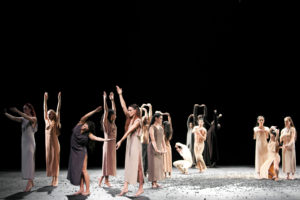
Sunday evening at the Staatsoper im Schiller Theater in Berlin, Sacre, directed by Sasha Waltz, was on.
The show, divided in three parts, opened with choreography to music by Debussy Prélude à l’après-midi d’un faune, inspired by the homonymous poem by Mallarmé.
Accompanied by the live orchestra, the Sasha Waltz & Guests ballet, dressed in costumes of bright colors and on a stage with an equally colorful backdrop, performed a dance made up of languid hugs, sensual caresses and sudden choral flashes that broke the fluidity of the movement.
In a performance devoid of virtuosity, the dancers were able to describe, with humor and sensuality, the dreamy tale of the Faun and his encounter with the Nymphs.
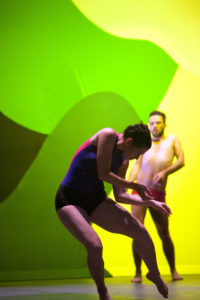
The second piece of choreography, accompanied by music from Roméo et Juliette by Berlioz, went on to talk about love.
As though amplifying the difference between the two stories – one erotic and the other romantic – only the two protagonists of the Shakespearian drama were alone on stage. The dance, which before had been physical and earthly, now became ethereal and delicate. During a pas de deux from the neoclassical school, the two young lovers filled the space spinning around and running after one another in sweet courtship.
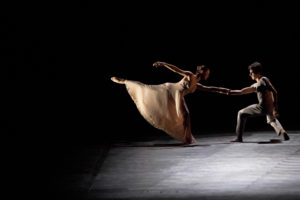
After a short interval, the show ended with Sacre du printemps by Stravinsky.
The last piece of choreography returned to the choral form; there were around thirty dancers on stage at the same time.
Beyond the romantic love of Romeo and Juliet and the lustful fantasies of the Faun, the ancient ritual of the Possession of the Virgin emerged in this final section.
A primitive and archaic dance which contrasts and separates groups of women and men into two sides. The first group, embracing and looking for each other, expressed feelings of solidarity and concern for the group, while men, who are more ‘bestial’, dance and jump around shirtless.

The ballet ends with the sacrifice of a woman.
The signal comes with the change in clothes of the chosen woman, who takes the earth-colored tunic off (as worn by the other women) and dresses up in a purple one.
During the grand finale, naked, under the blinding light cone, the victim dances until reaching a spasm of agony.
Whilst the group remains on the sidelines, watching her from a distance, she falls onto the pointed spear.
Once again Sasha Waltz offers a show that leaves the audience feeling enthusiastic.
The choreography of the three pieces perfectly accompanied Debussy, Berlioz and Stravinsky’s music. The first piece was compelling and engaging, followed by the less surprising pas de deux, and then the impactful finale, masterfully arranged by the famous choreographer.
There was a long duration of applause for the dancers and the orchestra – a well deserved success.














































